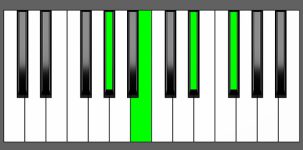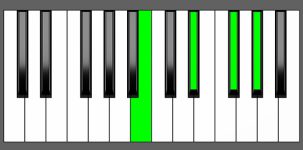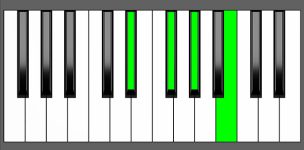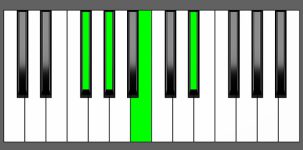Piano Diagram of Abm7 in Root Position

Abm7 is a minor chord built on the key of A-flat with an added minor 7th. It is formed by the notes Ab, Cb, Eb, and Gb. In this article, we’ll explore the music theory underlying the Abm7 chord, including its construction, common voicings, and its role in chord progressions.
Structure of Abm7
Notes |
|---|
| Ab, Cb, Eb, Gb |
Intervals |
|---|
| R, m3, 5, m7 |
Finger Position
Left Hand |
|---|
| 5, 3, 2, 1
5, 4, 2, 1 |
Right Hand |
|---|
| 1, 2, 4, 5
1, 2, 3, 4 |
Abm7 Chord Inversions
The Abm7 chord has a total of 3 inversions:
| Root Position: | Ab | Cb | Eb | Gb |
| 1st Inversion: | Cb | Eb | Gb | Ab |
| 2nd Inversion: | Eb | Gb | Ab | Cb |
| 3rd Inversion: | Gb | Ab | Cb | Eb |
Piano Keyboard Diagrams
Abm7 Chord Equivalencies
Rearranging the notes of a chord can result in unique and interesting chord equivalencies. This is particularly true for 7th chords, where we can create a distinct type of chord by rearranging the notes of a minor 7th chord in a specific way.
For instance, if we take the 1st inversion of a minor 7th chord, where the 3rd note becomes the root note, we end up with a major 6th chord (also known as an “add 6th” chord). Let’s consider the Abm7 chord, which comprises the notes Ab, Cb, Eb, and Gb. If we rearrange the notes such that Cb becomes the root note, we obtain a Cb6 chord with the notes Cb, Eb, Gb, and Ab.
1st Inversion of Abm7 = Cb6
The reason why the 1st inversion of a minor 7th chord results in a major 6th chord is due to the note relationships between the chords. When we move the 3rd note to become the root note, we end up with a chord that features a major 3rd, perfect 5th, and a major 6th interval.
Music Theory and Harmony of Abm7
In music theory, m7 chords, also known as minor seventh chords, are commonly used and have a melancholic or introspective quality. They can be found in various genres such as jazz, blues, pop, and classical music. These chords add richness and tension to a musical piece and are often used as tonic, subdominant, or dominant chords.
Building the Abm7 Chord: Different Approaches
When building a minor seventh (m7) chord, there are a few different approaches you can take. These approaches can be used interchangeably to construct m7 chords and provide different perspectives on building these chords:
Starting from the Ab Major Scale
Ab minor 7th is built by combining the Root, a minor 3rd, a 5th, and a minor 7th interval from a minor scale, however, for educational purposes, it may be clearer to demonstrate its construction using a major scale, as it better illustrates the relationship between intervals and their qualities.
For example, to build an Abm7 chord, you can start with the Ab Major scale, which consists of the notes Ab, Bb, C, Db, Eb, F, and G.


To create an Abm7 chord, apply the formula R, m3, 5, m7 in the following manner:
- Begin with the Root note, Ab.
- Select the 3rd interval, which is C then lower it down by a half-step to get the minor 3rd Cb. Even though Cb is enharmonically equivalent to a natural B, to preserve the chord’s interval structure, it is better to view it as C-flat (Cb). This approach helps maintain the integrity of the chord and its underlying interval relationships.
- Include the 5th note, Eb.
- Finally, add the minor 7th interval, Gb.
By following this simple formula, you can create a minor 7th chord from any major scale.
by Combining Intervals
Another way to form a minor 7th chord is by combining specific intervals – a minor 3rd, a major 3rd, and another minor 3rd.
m3 + 3 + m3 = minor 7th Chords
If we observe the intervals between the notes, we can notice that Ab-Cb creates a minor 3rd interval, Cb-Eb forms a major 3rd interval, and Eb-Gb is a minor 3rd interval. By stacking these three intervals together, we can build the Abm7 chord.
How to Use Ab min7 in a Chord Progression
Ab minor 7th can have various harmonic functions, depending on its context within a piece of music. Here you can see on what degrees it appears naturally, however, some of these scales fall under the category of theoretical keys.
A theoretical key refers to a key that exists in music theory but is not commonly used due to its impracticality. These keys often require the use of double flats or double sharps in their key signatures, which can make reading and notating the music more challenging.
To simplify things and make them more practical, it is generally recommended to use the enharmonic equivalent keys instead.
on Natural minor Scales
| Minor Scales | i | ii | III | iv | v | VI | VII |
|---|---|---|---|---|---|---|---|
| Ab | Ab min7 | Bbm7b5 | Cb Maj7 | Db min7 | Eb min7 | Fb Maj7 | Gb7 |
| Eb | Eb min7 | Fm7b5 | Gb Maj7 | Ab min7 | Bb min7 | Cb Maj7 | Db7 |
| Db = C# | C# min7 | D#m7b5 | E Maj7 | F# min7 | G# min7 | A Maj7 | B7 |
- Tonic chord in Ab minor
- Subdominant chord in Eb minor
- Dominant chord in C# minor as G#min7
on Major Scales
| Major Scales | I | ii | iii | IV | V | vi | vii |
|---|---|---|---|---|---|---|---|
| Gb | Gb Maj7 | Ab min7 | Bb min7 | Cb Maj7 | Db7 | Eb min7 | Fm7b5 |
| Fb = E | E Maj7 | F# min7 | G# min7 | A Maj7 | B7 | C#min7 | D#m7b5 |
| Cb = B | B Maj7 | C#min7 | D# min7 | E Maj7 | F#7 | G# min7 | A#m7b5 |
- Supertonic chord in Gb Major
- Mediant chord in E Major as G#min7
- Submediant chord in Cb Major as G#min7
Abm7 Function in Major and Minor Keys
Understanding Scale Degrees
To understand the relationships between the notes in a scale and their functions within chords, it’s essential to know about scale degrees. The diatonic major scale is made up of seven degrees, each with its own unique role in creating the overall harmony of the scale.
- Starting with the first degree of the scale, known as the Tonic, this note serves as the anchor for the music. It establishes a stable tonal center that acts as the foundation for the scale.
- Moving on to the second degree, called the Supertonic, is often used as a transitional note between the Tonic and other notes in the scale. It creates a sense of motion within the melody or harmony.
- The third degree of the scale is the Mediant, which sits halfway between the Tonic and Dominant notes. It helps establish whether the scale is major or minor.
- The fourth degree, known as the Subdominant, is used to complement the Dominant and add tension and resolution to the music.
- The fifth degree is the Dominant, which creates tension and anticipation within the melody or harmony. This note is typically resolved by returning to the Tonic.
- The sixth degree, the Submediant, is often employed as a transitional note between the Dominant and Tonic, adding a sense of stability and restfulness to the music.
- Finally, the seventh degree is the Leading tone, located one half-step below the Tonic. It creates a strong sense of tension and a desire to resolve to the Tonic. This note is frequently used to create a sense of resolution and finality in the melody or harmony.
Abm7 as Tonic Chord in Ab Minor
In the key of Ab minor, Abm7 can serve as the Tonic chord. This means that it’s the chord that creates a sense of stability and resolution, acting as the starting point and tonal center of the scale.
| i | ii | III | iv | v | VI | VII |
| Ab min7 | Bbm7b5 | Cb Maj7 | Db min7 | Eb min7 | Fb Maj7 | Gb7 |
Abm7 Chord Progressions as i degree
The following chord progressions are examples of how Ab minor 7th can serve as the tonic chord (i degree). I’ve added a possible voicing but it’s just a suggestion.
i VI VII III
| i | VI | VII | III |
| Ab min7
(Ab, Cb, Eb, Gb) |
E Maj7
(Ab, Cb, Eb, E) |
Gb7
(Gb, Bb, Db, E) |
Cb Maj7
(Gb, Bb, Cb, Eb) |
Chromatic modulation
| i | iΔ | i7 | i6 |
| Ab min
(Ab, Cb, Eb, Ab) |
AbmMaj7
(Ab, Cb, Eb, G) |
Ab min7
(Ab, Cb, Eb, Gb) |
Ab min6
(Ab, Cb, Eb, F) |
i iv VI VII
| i | iv | VI | VII |
| Ab min7
(Ab, Cb, Eb, Gb) |
Db min7
(Ab, Cb, Db, F) |
E Maj7
(E, Ab, Cb, Eb) |
Gb7
(E, Gb, Bb, Db) |
Abm7 as Subdominant Chord in Eb Minor
Ab minor 7th can also appear as the subdominant chord (iv degree) in the key of Eb minor.
| i | ii | III | iv | v | VI | VII |
| Eb min7 | Fm7b5 | Gb Maj7 | Ab min7 | Bb min7 | Cb Maj7 | Db7 |
Abm7 Chord Progressions as iv degree
The following chord progressions feature an Abm7 as the subdominant (iv degree):
iv III VI VII
| iv | III | VI | VII |
| Ab min7 | Gb Maj7 | Cb Maj7 | Db7 |
i iv VI v
| i | iv | VI | v |
| Eb min7 | Ab min7 | Cb Maj7 | Bb min7 |
Abm7 as Dominant Chord in Db Minor
Abm7 as Supertonic Chord in Gb Major
Although often associated with minor keys, Abm7 can also be used in major keys. In the key of Gb major, for example, Abm7 functions as the supertonic, which is located on the second degree of the scale.
In this context, Abm7 creates a slightly tense and unresolved sound, adding a feeling of anticipation or expectation as it typically leads to the dominant or subdominant chords.
| I | ii | iii | IV | V | vi | vii |
| Gb Maj7 | Ab min7 | Bb min7 | Cb Maj7 | Db7 | Eb min7 | Fm7b5 |
Abm7 Chord Progressions as ii degree
Try playing the following chord progressions to better understand how Abm7 functions as the supertonic (ii) chord in the key of Gb major.
ii V I
| ii | V | I |
| Ab min7 | Db7 | Gb Maj7 |
I IV ii V iii vi ii V
| I | IV | ii | V | iii | vi | ii | V |
| Gb Maj7 | Cb Maj7 | Ab min7 | Db7 | Bb min7 | Eb min7 | Ab min7 | Db7 |
Abm7 as Mediant Chord in Fb Major
Abm7 as Submediant Chord in Cb Major
Alternative Names for Abm7 Chord
- Ab-7
- Lab -7
- Lab m7
- Abm7th
- Ab min7
- LAb min7
- Ab minor 7th
- Ab minor seventh



